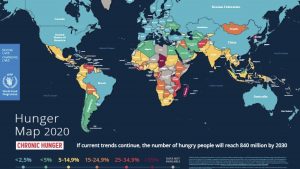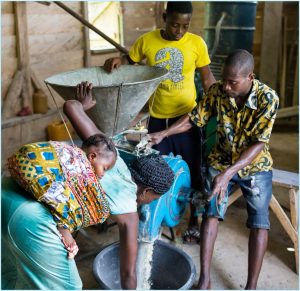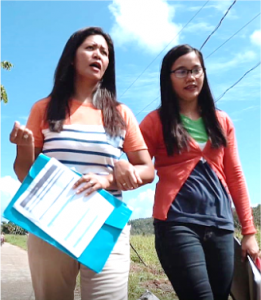 Sharon Eubank is Director, Latter-day Saint Charities; first counselor, General Relief Society Presidency, The Church of Jesus Christ of Latter-day Saints
Sharon Eubank is Director, Latter-day Saint Charities; first counselor, General Relief Society Presidency, The Church of Jesus Christ of Latter-day Saints
I thank our impressive Italian hosts for the organization of this year’s conference and am very pleased to join these distinguished speakers today. I attended the first G-20 Interfaith forum in 2014 and have seen it grown in attention and impact over the last 9 years. My name is Sharon Eubank and I’m the president of Latter-day Saint Charities, the humanitarian arm of the Church of Jesus Christ of Latter-day Saints.
The 17 Sustainable Development goals were originally determined by a coalition of world leaders to focus the conversation on 17 agreed-upon priorities. 3 of the goals correspond to the topic of today’s session: children, hunger, water/sanitation. However, the topic of sustainable development often gets overshadowed by emergency aid.
Although Latter-day Saint Charities and its partners do a significant amount of water and sanitation work around the world, I want to focus my brief remarks today on hunger, malnutrition, and childhood poverty because I believe there is the greatest opportunity for new action.
First, let me give some brief background on what COVID 19 has done to exacerbate hunger worldwide and then try to address my assigned topic: “In the face of the worsening situation, how can religious actors revamp and revitalize agendas?”
Despite international efforts and improvements in other areas of global development, world hunger has been on the rise since 2014.

This map shows where CHRONIC hunger is the most prevalent in the world. Chronic hunger is when people experience periodic seasons when they do not have enough food. The yellow, orange, and red colors are countries with a higher prevalence of hunger. Notice Haiti, Venezuela, Rwanda, Libera/Sierra Leone, and the east coast of Africa.
COVID 19 is further intensifying factors that lead to hunger in countries with already high rates of hunger and is also creating new pockets of food insecurity.
For me, three stark statistics from UNICEF spell out the utter urgency of global hunger in 2021.
- 1 in 3 children under age 5 are hungry
- 45% of child deaths are related to malnutrition
- In 2/3 of the world’s countries, women are more likely to be hungry than men
The causes that create those three statistics are not always straightforward or easy to address. Supply chain inefficiencies, gender inequality, climate change, disease, and conflict are the five major contributing factors to hunger around the world.
The effects of a global pandemic have been disastrous on food security. In 2019 135 million people were suffering from acute hunger. Now less than two years later the number has doubled to 272 million people. Even more startling, an additional 9.3 million children will experience “wasting” (shrinking muscle mass) by 2022.
One of the realities of the 21st century is that multilateral agencies are dealing with so many emergencies, one on top of another, that resources simply do not stretch. I highlight Yemen which has been labeled the “worst human-made disaster in the history of the modern world;” Southern Madagascar where 1.35 million people (doubled from last year) are food insecure and 11% of the children are wasting; and Afghanistan, where only this morning the warning was sounded that 1 million people may starve there before the end of the year. These situations drive home the point for those trying to mount a response: old approaches will not work. Like extreme weather—crises are getting bigger, longer, and can only successfully be addressed cooperatively.
It sounds controversial to say but, in my experience, too much resource by necessity has been devoted to food aid and not enough to food development. Of course, emergencies must be addressed, but ideally, we would address crises farther up the line before they explode into full-blown humanitarian disasters. To do this takes an understanding of those five root causes I mentioned earlier and an intentional focus on mitigating them over the long term.

One of the greatest predictors of child food security may surprise you. It is whether both parents live with the child. This Ghanaian family through a community program is using a communal grinding machine to make flour for their cooking and food storage. This simple, low-cost intervention—shared by other neighbors—allows the family to store a small surplus of food staples to sell or eat later and increases their stability. Community interventions that support families working together to increase their income rather than separating parents to work in distant locations will pay dividends for the next generation in both physical health and social cohesion.
Allow me to highlight three things Latter-day Saint Charities is doing with partners to “revamp and revitalize” its agendas in the face of COVID 19 and the associated food emergency.
Supply Chain Support
Supply chains for needed goods are always stressed during an emergency. A global pandemic has magnified that problem ten-fold. Even developed countries with complex distribution networks are seeing sudden shortages and unanticipated farm waste.
One of the immediate lessons Latter-day Saint Charities learned was that while efficient distribution channels are ideal, redundant channels are also needed. In other words—backup plans. To ease some of the pressure on supply chains, Latter-day Saint Charities invested $2 million toward strengthening the World Food Programme’s (WFP) hub and spoke logistical network. WFP has three global hubs and five regional “hubs” and dozens of “spokes” to move freight around the world. 45,000 tons of humanitarian medical supplies and food passed through these hubs in just the last few months. These paths grew more critical as other supply chains were disrupted by the pandemic. The hub and spoke network is open to many humanitarian organizations to use. It increases efficiency but it also has built-in redundancies. This helped keep critically needed humanitarian supplies moving.
Women as Agriculture Leaders
Latter-day Saint Charities increased partnerships with a series of organizations like International Development Enterprises that help develop women as agricultural leaders. Beatrice, whom you see in this photo wearing the black shirt, is a Farm Business Advisor in Zambia. Surrounding her are the other women farmers she supports. Beatrice teaches proven farming techniques and brokers relationships between seed suppliers and markets so that her clients can improve their gardens and increase their incomes.

When the pandemic hit, Beatrice was also trained by the Zambian Ministry of Health to teach her farmer clients about COVID-19 prevention. This farming peer-group developed a strong network to support one another in a wide variety of activities.
This turned out to be key learning. It is relatively easy to distribute food aid. It is a much more complex effort to change the culture around farming practices, food consumption, diet, and nutrition. In the end, change is really only accomplished through consistent personal relationships of trust.
Community Nutrition Councils
This hope to build more trusting relationships led to the revamping of our approach to community nutrition. Patterned after agriculture leaders like Beatrice and her council of farmers, Latter-day Saint Charities began supporting Community Nutrition Councils. After a baseline screening to identify children who were moderately or severely malnourished, local citizens’ councils were created to learn more about how to help their children eat more nutritiously. They partnered with the local government for additional resources. This worked best at the village and municipal levels.

Family food is a women’s realm in most places. In these photos you see three women in Paris, France working with new immigrants in the city and also 2 women in Catarman, Philippines. Their community nutrition councils had a simple approach that included:
- Visiting the families as often as necessary to understand their needs
- Ensuring families are aware of the availability of nutritional supplements and deworming medicine
- Screening and tracking progress in children’s weight and height
- Sharing simple, local, health and nutrition lessons with parents
- Sharing recipes that use more fruits and vegetables
- Helping plant gardens or raise small animals.

These are for the most part low-cost, low-tech interventions that can have huge health benefits. Families become more resilient with knowledge and resources. I happily acknowledge the very fine work of Catholic Relief Services, IsraAID, Adventist Relief and Development Agency, Islamic Relief, and Rise and Rebuild as partners in this holistic food security approach at the community level.
Conclusion
The G-20 Interfaith Summit has as its theme for 2021: A Time to Heal. The coronavirus has inflicted wounds that aren’t simply about COVID-19. Food insecurity is one of the unexpected scars. In large measure, faith communities are focused on the holistic healing of body and spirit. Some of the finest social service work in the world is being offered by communities motivated by their love of God and love of their fellow man—the two great commandments. The Church of Jesus Christ of Latter-day Saints lays claim to this great, energizing mandate.
l would like to extend two calls to action to the G-20 leaders as they meet next month in Rome.
- Ask your faith communities for data and progress reports specifically on 17 Sustainable Development Goals. You will be surprised at their scope.
- Invest aid dollars early on, before crises unbearably hit the news. Holistic approaches can do much to heal the root causes of hunger.
I will conclude with the words of Jesus Christ as recorded in the New Testament, Matthew 25:
For I was an hungered, and ye gave me meat; I was thirsty, and ye gave me drink; I was a stranger, and ye took me in. … Inasmuch as ye have done it unto one of the least of these my brethren, ye have done it unto me (35, 40).
In this great innovative age of so much wisdom and plenty, let our generation be the one where children have meat.
Thank you.
See Sister Sharon Eubank’s video presentation: https://youtu.be/zBhq_1HPScE?t=1312
